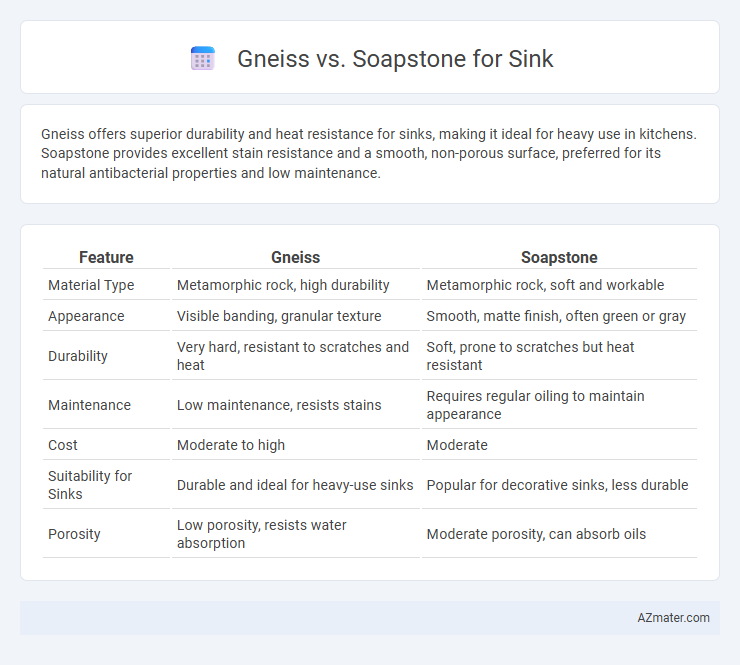Gneiss offers superior durability and heat resistance for sinks, making it ideal for heavy use in kitchens. Soapstone provides excellent stain resistance and a smooth, non-porous surface, preferred for its natural antibacterial properties and low maintenance.
Table of Comparison
| Feature | Gneiss | Soapstone |
|---|---|---|
| Material Type | Metamorphic rock, high durability | Metamorphic rock, soft and workable |
| Appearance | Visible banding, granular texture | Smooth, matte finish, often green or gray |
| Durability | Very hard, resistant to scratches and heat | Soft, prone to scratches but heat resistant |
| Maintenance | Low maintenance, resists stains | Requires regular oiling to maintain appearance |
| Cost | Moderate to high | Moderate |
| Suitability for Sinks | Durable and ideal for heavy-use sinks | Popular for decorative sinks, less durable |
| Porosity | Low porosity, resists water absorption | Moderate porosity, can absorb oils |
Introduction to Gneiss and Soapstone Sinks
Gneiss and soapstone are popular materials for sinks due to their durability and unique aesthetic qualities. Gneiss sinks boast a striking, banded texture formed through high-grade metamorphic processes, offering resistance to heat and scratches, making them ideal for busy kitchens. Soapstone sinks, composed primarily of talc, provide a smooth, matte surface that is naturally resistant to stains, bacteria, and heat, often gaining character with age through subtle patina changes.
Geological Origins and Composition Comparison
Gneiss, a metamorphic rock formed from high-grade metamorphism of granite or sedimentary rock, exhibits distinct banding due to its foliated mineral composition, primarily quartz, feldspar, and mica, providing durable and heat-resistant properties ideal for sinks. Soapstone, a talc-rich metamorphic rock derived from altered dolomite or magnesium-rich rocks, contains a high percentage of talc, giving it a soft, soapy texture and excellent chemical resistance but with lower hardness compared to gneiss. The geological origins and mineral makeup determine gneiss' harder, more textured surface versus soapstone's smoother, more malleable nature, impacting durability and maintenance in sink applications.
Visual Appeal: Color and Texture Differences
Gneiss sinks showcase a striking visual appeal with their banded, coarse-grained texture and a color palette ranging from light gray to pinkish hues, providing a natural, rugged elegance. Soapstone sinks offer a smooth, matte finish with consistent coloring often in shades of dark gray to deep green, emphasizing a soft, almost velvety appearance. The contrasting textures and colors make gneiss ideal for bold, dramatic kitchen designs, while soapstone suits minimalist, understated aesthetics.
Durability and Hardness: Which is Stronger?
Gneiss offers superior durability and hardness compared to soapstone, making it a stronger choice for sinks subjected to heavy use and impact. With a Mohs hardness rating around 6 to 7, gneiss resists scratches and abrasions more effectively than soapstone, which typically rates between 1 and 2. Soapstone's softness provides some flexibility and heat resistance but sacrifices strength and long-term durability compared to the robust crystalline structure of gneiss.
Maintenance Requirements for Each Material
Gneiss sinks require regular sealing to prevent staining and maintain their polished appearance, as the natural stone is somewhat porous and prone to moisture absorption. Soapstone sinks are highly resistant to staining and bacteria, needing only occasional oiling with mineral oil to enhance their smooth, matte finish and prevent dryness. Both materials demand mild, non-abrasive cleaners to avoid surface damage, but soapstone offers lower long-term maintenance due to its natural durability and chemical resistance.
Resistance to Staining and Etching
Gneiss offers excellent resistance to staining and etching due to its hard, crystalline structure composed mainly of quartz and feldspar. Soapstone is also highly resistant to staining because of its non-porous nature but is more susceptible to etching and scratching as it is composed primarily of talc and magnesium silicate. When selecting a sink material, gneiss provides superior durability against chemical wear, while soapstone may require more maintenance to maintain its appearance over time.
Heat Resistance: Handling Hot Pots and Pans
Gneiss offers excellent heat resistance, making it a durable choice for sinks that frequently handle hot pots and pans without cracking or discoloring. Soapstone is highly heat resistant as well and can tolerate direct contact with hot cookware, often even used as a surface for hot pots to cool down safely. Both materials provide reliable thermal endurance, but soapstone's slightly softer composition allows it to absorb and distribute heat more evenly, reducing the risk of thermal shock.
Cost Comparison: Price of Gneiss vs Soapstone Sinks
Gneiss sinks typically range from $200 to $600, offering a mid-tier price point due to their durability and unique veining patterns. Soapstone sinks generally cost between $400 and $900, reflecting their higher resistance to heat and staining as well as their natural, smooth texture. Choosing between Gneiss and Soapstone often depends on budget constraints and desired aesthetic, as Soapstone sinks tend to be pricier but provide superior longevity and maintenance benefits.
Installation Considerations: Weight and Support
Gneiss sinks require robust structural support due to their dense, heavy nature, often necessitating reinforced cabinetry or additional bracing during installation. Soapstone sinks are lighter, offering more flexibility in mounting options and typically reducing the need for extensive support systems. Both materials demand precise measurements and professional handling to ensure secure, long-lasting installation without compromising countertop integrity.
Best Applications: Which Sink Material Suits Your Needs?
Gneiss sinks offer exceptional durability and resistance to heat, making them ideal for heavy-use kitchens and outdoor settings where toughness is essential. Soapstone sinks provide natural non-porous qualities, excellent chemical resistance, and a smooth, warm feel, perfect for applications requiring easy maintenance and a vintage aesthetic. Choosing between gneiss and soapstone depends on whether durability and heat resistance or smooth texture and stain resistance align better with your specific sink needs.

Infographic: Gneiss vs Soapstone for Sink
 azmater.com
azmater.com